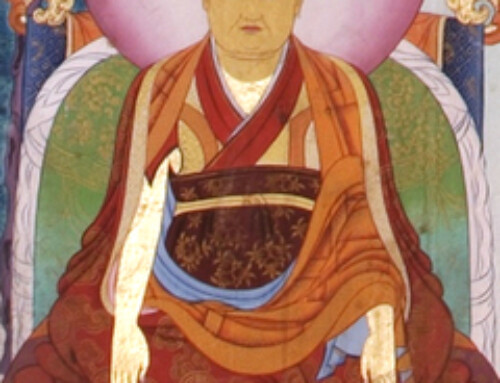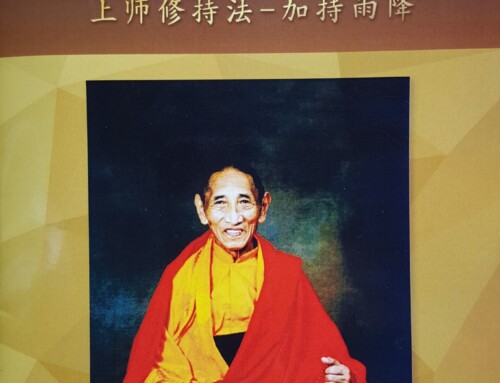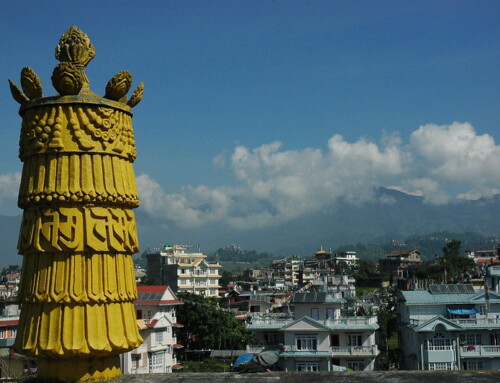The profound view of the Middle Way
Is settled by realization of interdependence,
Who can keep from developing faith
In the Teacher of shunyata and interdependence?
The space of your eloquent teachings
Cannot be measured by the minds of infants
Yet, in order to benefit some who are like me,
I write this, like pointing my finger at a mountain.
Having praised and prostrated to Shakyamuni Buddha with indestructible, heartfelt faith, since our yearly retreat is on the Heart Sutra, I thought to write briefly on the subject of the Heart Sutra in order to make it easily understandable. Because the meaning of the Heart Sutra is very profound and vast, using many Dharma words, I thought it might be helpful if I set forth my understanding of it in straightforward ordinary language, so that later it could be compared with the root scripture.
In order to guide living beings from happiness to happiness Buddha turned the wheel of Dharma three times: first the Dharma wheel of the Four Noble Truths; in the middle, the Dharma wheel of absence of characteristics; and finally, the Dharma wheel of fine discrimination. The Heart Sutra is a scripture from the middle wheel, teaching profound emptiness. There is a tradition of calling the Heart Sutra, literally, the Essence of Wisdom Sutra, the Mother Essence of Wisdom. Why is it called the Mother? It is like a Mother because it is practicing this path realizing the meaning of emptiness that the Buddhas and Bodhisattvas finally attain the state of a Buddha. We all come from a mother. Depending upon the view of emptiness is like a source of going from happiness to happiness.
There are long, middling, and short versions of this middle-wheel teaching of the profound Middle Way path of the Mother. The extensive one is an extremely large volume of seven to eight hundred pages, with a hundred thousand four-line verses. The middling one has twenty-five thousand verses in three volumes. The short version is still very long with eight thousand verses. The extremely short version is the Heart Sutra we are studying today. It is said by scholars that it has twenty verses. To count verses you need to actually have verses, however, and the Heart Sutra is in prose! In any case, they say it has twenty-something verses. Some also call it the Twenty-Verse Perfection of Wisdom, giving it the name of the supposed number of verses.
There is a still shorter version called the Perfection of Wisdom in a Single Letter. What is it? It is AH. In Tibetan written like this: ཨ That single syllable includes the entire meaning of the long, middling, and short versions of the Essence of Wisdom Sutras.
Now I’ll explain the essential meaning of the Heart Sutra. Because the Heart Sutra is extremely profound I will be giving only a short commentary. If this doesn’t help, it would be good to study His Holiness the Dalai Lama’s commentary that has been translated into English.
In general, the extensive, middling, and short versions of the Perfection of Wisdom Sutra were all spoken by Buddha. This one, however, was not. It is a teaching blessed by Buddha. Why is it blessed? Because it was blessed by the power of Buddha’s samadhi, his deep meditative absorption. Who was blessed? The supreme of the Shravakas, Shariputra, and the supreme of the Bodhisattvas, Avalokitesvara. What place was blessed? The site near present-day Bodhgaya, India, Vulture’s Peak. How was it blessed? Those two were emboldened to have a discussion, with Avalokitesvara answering the question put forth by Shariputra, and then finally Buddha arose from his meditative equipoise and congratulated and praised them both. It is a special Sutra in this regard.
The actual meaning of the Heart Sutra is the emptiness that is the object of analytical meditation in the Sutra system. For example,
Form is emptiness, emptiness is form
Emptiness is no other than form, form is no other than emptiness.
In the same way, sound, smell, taste, touch…
This is all the objects of the five senses. This presents the real meaning of the Heart Sutra. According to Buddhist philosophy and practice, all things are empty of existing from their own side. What is the reason? Because they are interdependent. All things arise by the power of interdependence. Whatever is interdependent is emptiness.
Nagarjuna said,
There is nothing that is not empty.
Therefore, there is nothing that is not interdependent.
It is like that. This is not saying that form which is the object of eye consciousness is completely nonexistent, but that if we seek with ultimate analysis the form that we are currently seeing, we will not find it. That factor of form being empty of itself is asserted to be emptiness. Form’s emptiness and the form we see are one nature only differentiable by thought. There is no emptiness that exists separate from form, and no form that exists separate from emptiness. Form is empty and emptiness is form because form and emptiness are non-dual. Because it is empty, form may appear as a conventional thing, and because it does not truly exist from its own side, it may appear as emptiness. Appearance does not negate form’s being empty, and form’s emptiness does not prevent it from appearing. This is the special feature of the Middle Way.
For example, if you don’t analyze an object appearing before you it seems to truly be the same thing it was yesterday and the day before. If you analyze it, however, it continually arises through the force of many causes and conditions and particles of matter. That collection of causes and conditions also exists in interdependence; it couldn’t arise without causes and conditions. Things that arise through the power of interdependence do not remain for even a moment. They arise and cease; that itself is impermanence. As long as something arises in dependence upon causes and conditions it is empty. That is the reason Buddha said,
One who understands dependent arising, sees the Dharma.
One who sees the Dharma sees the Buddha.
In brief, these things we see as the objects of our five senses that seem to truly exist with their own characteristics of shape, color, and so on, do not appear to a Buddha. What appears to a Buddha? The unreality of forms: appearing like illusions, like mirages, like bubbles. The things that appear are the same for a Buddha, but there is no dualistic grasping of them to be real. Buddhas see them to be like illusion or dream, whereas, to limited sentient beings they appear to truly exist as they appear to their dualistic ignorance.
We may ask, Well, then, are the objects that I see and hear, that effect me, not real? Other than appearing as they do, to mistaken awareness, they do not exist for correct awareness. These things that appear in our vision, the five objects of the senses, appear to ordinary beings when they are not subjected to ultimate analysis. When analyzed by way of the great reasoning of interdependence, things do not truly exist from their own side, like dreams and bubbles, for example.
The more you realize that things don’t truly exist from their own side, the more your mistaken attitudes of attachment and aversion will automatically diminish in force. Because your attachment and aversion weaken, the right view of emptiness will gradually become clearer and clearer. As one gets stronger the other gets weaker; that is their nature. There is no way that which is being abandoned can coexist with its antidote, like light and darkness for example. If we grasp what we are seeing and hearing, all the objects of our senses, as valid, we will never discover any ultimately valid awareness.
As said in the King of Samadhis Sutra,
Eyes, ears, and nose, are not valid.
Tongue, body, and ordinary mind are not valid.
If these sense consciousnesses were valid
What could the Arya path do for anyone?
If you want a perfect understanding of Buddhadharma you definitely must understand the workings of interdependent origination. Anyone who wishes to free themselves from samsara must understand dependent origination from the perspective of the profound Middle Way philosophy. If you have a good understanding of dependent, or contingent, origination, from that moment onwards understanding of emptiness dawns. If you realize emptiness it becomes an antidote to the delusions. If you are freed from delusion, from that moment you are liberated from samsara. Although there are many different religions in the world, none but Buddha teaches interdependence and selflessness, shunyata. Knowledge of those two, interdependence and emptiness, is knowledge of what is the real special quality of Buddha’s teachings. When present day scientists, after many years of hard work, discover a little about interdependence they are surprised! With no need of modern instruments and electricity, Buddha already realized it using his own discriminating wisdom twenty-five hundred years ago! Because of this many learned scientists are captivated by Buddhism and Tibetan Buddhism in particular, and follow it.
The Heart Sutra mantra itself teaches the entire way of liberation from samsara. The mantra is
TAYATA GATÉ GATÉ PARAGATÉ PARASAMGATÉ BODHI SVAHA
The meaning is Go! Go! Go beyond! Go completely beyond to abide in enlightenment. The mantra can be conjoined with the five inner paths to enlightenment. The first ‘Go!’ means the path of accumulation. The second ‘Go!’ means the path of preparation. The third ‘Go’ means the path of seeing, and the fourth ‘Go’ means the path of meditation. Bodhi Svaha refers to the fifth path of no more training, enlightenment.
The Heart Sutra is very precious and sacred. Its meaning is extremely profound so it would be very difficult to understand it completely with only a few sessions of study. Yet we should know that we are extremely fortunate to hear, contemplate, and meditate on this profound holy teaching.
As Je Tsongkhapa said in his Praise of the Perfection of Wisdom,
Writing, reading, honoring, this scripture
is especially exalted over others.
Studying the commentary with its reasoning
over and over, one is indeed fortunate!
As he says in his praise, we are extremely fortunate.
Final Prayer
The benefit of hearing one time
This teaching on interdependent origination
Is inconceivable, it is said in sutras.
Therefore, I think we are very fortunate.
The root of delusions is confusion, likewise
The root of phenomena is interdependence, Buddha taught.
Hearing this and contemplating it,
Joy in my heart expands by leaps and bounds.
Interdependence, the greatest of reasonings,
Settles the nature of all to be known.
All phenomena appear as empty, yet
Appearance and emptiness are an equality, not contradictory.
In this life and all my lives, I pray
I may understand this king of reasoning
and follow its unerring path
to the realization of emptiness.
I have written this brief explanation of the essential meaning of the Heart Sutra for the occasion of our Heart Sutra Retreat. The Heart Sutra is the essence of all the Mother Perfection of Wisdom Sutras, long, middling, and condensed. Its words are few but its meaning is extremely profound. Although it is difficult to understand completely by studying it one time, for us to place just one imprint of this profound teaching in our being, both guru and disciples create and accumulate immeasurable merit. Everyone please remember this.
Hoping this would be helpful for our retreat, I, Khenpo Karten wrote this for easy clarification of the essential meaning of the Heart Sutra on February 10, 2019.
Translation by Jampa Tharchin





